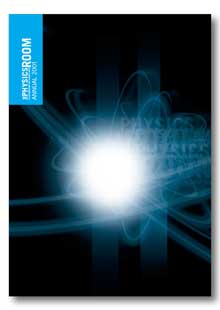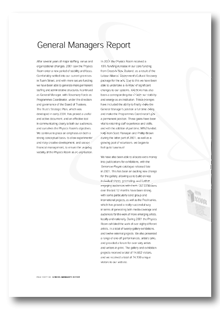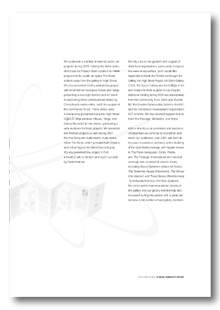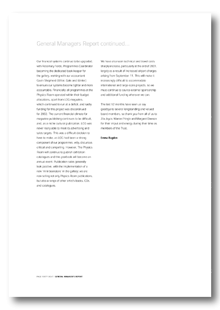 |
|||||||||
|
|
| ...Publications: Annual | ...General Managers Report | ||||||||
|
After several years of major staffing, venue and organizational changes, 2001 saw the Physics Room enter a new period of stability and focus. Comfortably settled into our current premises in Tuam Street, and with more secure funding we have been able to generate more permanent staffing and administrative structures. I continued as General Manager, with Rosemary Forde as Programmes Coordinator, under the direction and governance of the Board of Trustees. The Trust’s Strategic Plan, which was developed in early 2001, has proved a useful and active document, and an effective tool in communicating clearly to both our audiences, and ourselves the Physics Room’s objectives. We continue to place an emphasis on both a strong conceptual basis, to allow experimental and risky creative development, and secure financial management, to ensure the ongoing viability of the Physics Room as an orgnisation. In 2001 the Physics Room received a 19% funding increase in our core funding from Creative New Zealand, as a result of the Labour Alliance Government’s Cultural Recovery package for the arts. Due to this we have been able to undertake a number of significant changes to our systems, and there has also been a corresponding rise in both our stability and energy as an institution. These changes have included the ability to finally make the General Manager’s position a full time salary, and make the Programmes Coordinator’s job a permanent position. These gains have been vital to retaining staff experience and skills, and with the addition of part time, WINZ funded, help from Scott Flanagan and Phillip Brown during the latter part of 2001, as well as a growing pool of volunteers, we began to feel quite luxurious! We have also been able to allocate extra money into publications for exhibitions, with theTomorrow People catalogue released late in 2001. This has been an exciting new change for the gallery, allowing us to build on key individual shows, promoting, and further engaging audiences with them. Our exhibitions over the last 12 months have been strong, with some particularly solid group and international projects, as well as the Fresh series, which has proved a really successful way, in terms of generating both media coverage and audiences for the work of more emerging artists, locally and nationally. During 2001 the Physics Room exhibited the work of over eighty different artists, in a total of twenty gallery exhibitions, and twelve external projects. We also presented a range of one-off performances, artist’s talks, and provided a forum for over sixty artists and writers in print. The gallery and exhibition projects received a total of 14,662 visitors, and we received a total of 74,190 unique visitors to our website. We undertook a number of external public art projects during 2001, notably the Kiosk series, which saw the Physics Room curate a six month programme for public art space The Kiosk, a block away from the gallery in High Street. We also presented Craft a partnership project with local fashion boutiques Novak and Tango, presenting a one night fashion and art event incorporating three commissioned videos by Christchurch media artists, (with the support of the Community Trust). These videos were subsequently presented along the High Street region in shop windows (Novak, Tango, and Galaxy Records) for two weeks, generating a wide audience for these projects. We presented two Internet projects as well during 2001, the first being the multi-media, multi-venue eventThe Picnic, which provided both physical and virtual spaces for interaction and play. We also presented the project 4 EVA, a musical ode to fandom and mp3’s curated by David Hatcher. We rely a lot on the goodwill and support of other local organisations, particularly in regards the loans of equipment, and I would like especially to thank the Robert McDougall Art Gallery, the High Street Project, the SOFA Gallery, COCA, the Space Gallery and the College of Art and Design for their support of our projects. Additional funding during 2001 was also received from the Community Trust, Work and Income NZ, the Creative Communities Scheme, the EAF, and the Canterbury Development Corporation’s ACE scheme. We also received support in kind from The Package, Montieths, and Bryco. With a new focus on promotion and audience development we continue to strengthen and widen our audiences, and 2001 saw both an increase in audience numbers, and a doubling of the local media coverage, with regular reviews in The Press newspaper, Canta, Presto, and The Package. International and national coverage was received for several shows, including Neural Notations (Asian Art News), The Tomorrow People (Pavement), The Dinner (the Listener) and Travel Stories Otira/Germany -Schnittstelle/Interface (Art New Zealand). We continued to host educational classes at the gallery, and our gallery membership also increased during this period, with a particular increase in the number of local gallery members. Our financial systems continue to be upgraded, with Rosemary Forde, Programmes Coordinator becoming the dedicated book keeper for the gallery, working with our accountant Gavin Shepherd (Miller, Gale and Winter) to ensure our systems become tighter and more accountable. Financially, all programmes at the Physics Room operated within their budget allocations, apart from LOG magazine, which continued to run at a deficit, and sadly, funding for this project was discontinued for 2002. The current financial climate for magazine publishing continues to be difficult, and, as a niche cultural publication, LOG was never really able to meet its advertising and sales targets. This was a difficult decision to have to make, as LOG had been a strong component of our programmes, witty, discursive, critical and compelling. However, The Physics Room will continue to publish exhibition catalogues and this yearbook will become an annual event. Publication sales generally look positive, with the implementation of a new ‘mini bookstore’ in the gallery; we are now selling not only Physics Room publications, but also a range of other artist’s books, CDs, and catalogues. We have also seen technical and travel costs sharply increase, particularly at the end of 2001, largely as a result of increased airport charges arising from September 11. This will make it increasingly difficult to accommodate international and large-scale projects, so we must continue to source external sponsorship and additional funding wherever we can. The last 12 months have seen us say goodbye to several longstanding and valued board members, so thank you from all of us to Zita Joyce, Warren Pringle and Margaret Dawson for their imput and energy during their time as members of the Trust. Emma Bugden This essay originally appeared in The
Physics Room Annual 2001 Order your copy today from The
Physics Room !
|
||||||||



